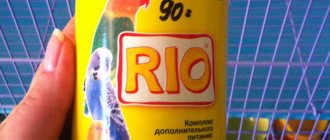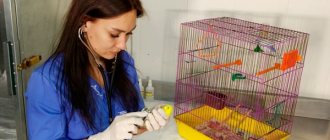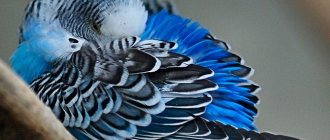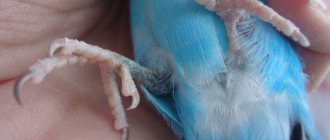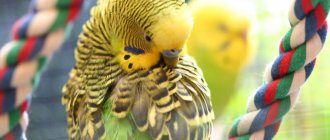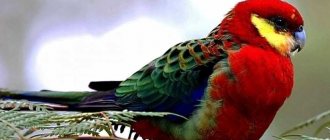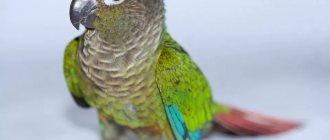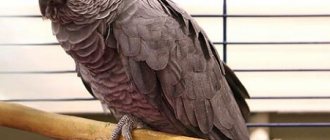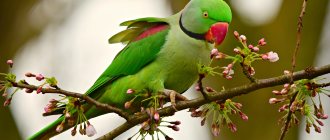Parrots are very curious, active and energetic birds. Each species of the parrot family has an individual character. Some individuals are mannered and show their importance. Others are restless and perform graceful tricks. Attentive owners, observing the behavior of their pet, notice how the parrot shakes its head.
Domestic birds are very friendly. One of the reasons for this unusual behavior is the bird's desire to attract attention. A possible reason could be a simple desire to scratch the back of your head. In this case, the parrot shakes its head up and down, trying to get rid of irritation. In this case, the cage bars are used as a “comb”.
The presence of such a symptom may indicate stress, headaches or injuries received during the flight. Adults can painfully tolerate sudden changes in atmospheric pressure. Strange movements are observed in birds experiencing nausea. The disease is accompanied by food falling out of the beak or regurgitation of food.
Stress
Stress in a bird can manifest itself as trembling. It is necessary to find out why the bird began to feel chills. Loud sounds, unknown people and animals can cause an anxious reaction in a parrot, which, in the absence of its owners, is frightened by the aggressive behavior of other pets - cats or dogs. A change in home, environment, or owner also negatively affects the condition of the bird.
There is no need to panic. It is necessary to create a calm, friendly environment for the pet, allow the bird to look around and settle in, and eliminate loud and harsh sounds. Over time, the pet will calm down and the trembling will go away.
Habits and behavior of a budgerigar
Budgerigars are distinguished by their cheerfulness. They are carefree and cheerful throughout the day. The owner's arrival, the sun outside the window, pleasant music and many other little things bring them joy. And they show their feelings by cheerful chirping and tilting their heads from side to side.
Important! Staying alone for a long time can make your pet depressed. This condition is dangerous for health and mental problems.
It is important to pay enough attention to such birds. If a pet lives alone in a cage, it will look for any communication with a person. And in his absence, sit on a perch. And if at first the behavior of a budgerigar is aimed at attracting the attention of others, then later he will find entertainment on his own. To alleviate the loneliness of the bird, a sufficient number of toys are placed in the cage. This could be a mirror, a bell, etc.
Important! It is important to pay attention to your pet every day: at least 5–10 minutes in the morning and the same amount in the evening. Free flights around the room are also important for a pet's comfortable life.
By the behavior of the parrot, an attentive owner will learn about the current mood of the bird. Despite their cheerfulness, birds can be sad, experience fear and other negative emotions. Also, changing his behavior allows him to detect health problems in the early stages.
Avitaminosis
The parrot is shaking due to a lack of vitamins. You should consult your veterinarian about this. Perhaps changing the food to one enriched with microelements will help. After consultation, a vitamin supplement is chosen for the main diet. Feeding with fresh vegetables and fruits cannot be ignored. Almost everything suits parrots except papaya, persimmons and nuts. It is also necessary to offer the bird greens:
- sorrel;
- dandelions;
- wheatgrass;
- shepherd's bag
The main thing is to find out in time why the parrot begins to shake.
Paw diseases
The most common "foot diseases" in parrots are: calluses (calluses on the soles of the feet), overgrown nails, injuries (caused by improper equipment or toys and bites from other parrots), lameness and paw twitching.
Namins (pododermatitis) is a syndrome, i.e. a complex of symptoms that appear in many infectious and non-infectious diseases of parrots. First, the nutrition of the skin of the foot is disrupted, and later infectious complications develop; bacteria and fungi begin to develop in weakened skin, and if the process is not stopped, the infection spreads deep into the tissues of the paws and affects the bones. The root cause predisposing to the development of pododermatitis may be a lack of vitamin A, kidney disease of the parrot, impaired innervation in the lumbar spine, arthritis of the paw joints, and irregular shape of the perches. The earliest sign of the development of namins is calluses and thinning of the skin on the soles of the toes and the center of the foot - while the parrot does not limp and generally does not show noticeable signs that alert the owner.
| Cockatoo parrot sole. The arrow indicates the inflamed fissure. Pay attention to the thickened skin of the parrot’s feet - this is hyperkeratosis, a consequence of various diseases. The cause of thickening of the skin of the feet of parrots can be fungal and viral infections, lack of vitamin A in the diet. |
If you notice calluses on your parrot’s fingers, contact your bird doctor; don’t expect complications.
| Paw of a yellow-crested cockatoo. Thin skin on the paws indicates kidney disease and impaired innervation. Growths on the sole of a parrot can be associated with viral and fungal infections, as well as vitamin deficiency A. The arrows indicate growths on the sole (hyperkeratosis) and thinning of the skin of the fingers. Notice that this parrot's toes look like a withered tree branch - this is an important sign that the parrot is sick. |
| The condition of the skin on a parrot's paws indicates the condition of the bird's kidneys, the condition of the spine, and much more. In this photo, the arrows show areas of thinning skin on the feet of a green-winged macaw. Such areas on the parrot's paws can also indicate healed injuries after bites. |
Why is he shaking his head?
A parrot shakes its head for many reasons:
- grains stuck in the crop;
- injury;
- nausea;
- the presence of a tracheal mite;
- tumor of the swallowing organs.
Attention! You should not ignore symptoms such as vomiting, loose stools, nausea, and stretching of the neck. The slightest delay can cost the bird's life.
First you need to examine the bird and find the reason for this behavior. The beak, plumage, and paws are carefully examined.
Bites
In the life of young parrots, there is often a period of “biting”, when inexperienced birds “test the teeth” of everything they come into contact with. The parrot's beak is literally strewn with nerve endings, and therefore is used by birds to determine the texture, taste, elasticity and other tactile properties of the object of study. In such cases, biting cannot be considered as hostile actions, it is just research. Finger biting, which can later develop into a biting habit, can be gently switched to a toy or some edible object.
In older birds, biting is one of the most obvious forms of expressing displeasure. A parrot will never bite without a reason. She may feel threatened, scared, or anxious. This behavior is possible during mating games, when protecting the nest, or if the owner does something that is unpleasant to the parrot. Birds may even bite their partner or beloved owner in an attempt to protect them. Instinct prompts the bird to retreat from danger and bite its partner, prompting similar actions; the same instinct can make a parrot bite its owner. Biting can also be caused by displacement of aggression - i.e. if it is impossible to bite what it wants, the parrot will gnaw on what it can reach. When encouraging a bird to come to your hand, do not perceive an open beak aimed at you as a threat. Birds will almost always “test” a branch before placing their weight on it to make sure it is strong, and they will also touch your hand with their beak before landing on it.
Possible cause: goiter blockage or tumor
If a bird frequently nods its head and closes its eyes, it is trying to free itself from food stuck in its crop. A pet may make frequent head movements if it has a tumor under its goiter. This can be easily determined by palpation. Ignoring this symptom will lead to the inevitable death of the pet.
Head movements are repeated by individuals experiencing nausea. The disease is accompanied by food falling out of the beak and regurgitation.
Trying to speak
In most cases, parrot owners get these birds in the hope that they will start talking. That’s why they conduct classes every day and play recordings for the pets. In this case, the reason why a cockatoo, cockatiel or budgerigar opens its mouth or opens it slightly as if talking is understandable.
He tries to repeat sounds or words, but so far without success. The same thing sometimes occurs when the TV is loud in the room or music is playing. In this case, the pet will probably start talking soon.
Tracheal mite
This avian parasite causes a disease called sternostomosis. This disease affects the internal organs, larynx and trachea. Due to difficulties with swallowing and breathing, the parrot begins to actively shake its head and may even spit out grains. You can understand why a parrot shakes its body if you track other symptoms. At first, there is a partial loss of voice, coughing, and wheezing.
To accurately diagnose the disease, it is necessary to take a tracheal smear to check for parasites. A litter analysis is also needed. If the test shows the presence of mites, the veterinarian will prescribe treatment.
Important! The dosage of medications, the treatment itself and its duration are determined only by a specialist.
The prescribed medications are taken for about 2 weeks.
Beak deformation
The beak of parrots performs many functions. Birds take food with them, get seeds from plants and berries, crack nuts, try unfamiliar objects, build a nest, clean feathers and even defend themselves. By nature, it is very strong, since it is based on calcium. But sometimes, due to improper feeding, the tissues of the beak soften and it changes shape. This affects the general condition of the pet, since the parrot cannot eat and breathe normally.
It is not difficult to correct the situation and return the beak to its previous shape: food rich in calcium should be included in the bird’s diet.
Goiter inflammation
This is a disease of granivorous birds, often occurring with vague symptoms. The main symptom is inflammation of the goiter sac. In addition, the bird:
- shakes and stretches his neck;
- behaves restlessly;
- constantly regurgitates food;
- becomes lethargic;
- refuses food.
In advanced cases, the parrot spits out food, the mucous membranes become bluish, and the crop sags. The pet cannot swallow at all, its beak often opens, viscous saliva appears, and the feathers on its head stick together. The bird subsequently dies. This condition leads to:
- poor quality food;
- poisoning from toxic plants or chemical vapors;
- complication after infectious diseases.
It happens that a bird does not receive the necessary mineral elements and compensates for them by stuffing its crop with grain, which leads to inflammation.
The disease is often detected at a stage when it is practically impossible to help the pet. As a rule, treatment at home cannot save the bird; an urgent visit to the veterinarian is necessary. It is important not to miss the symptoms and find out why your pet parrot's head begins to shake.
For this purpose, an examination is carried out. Antibiotics are used only if the infectious origin of the disease is confirmed. In parallel with the main treatment, medications are given to support the liver. To avoid exhaustion, the bird is fed liquid porridge.
Prevention
Knowing the causes of diseases, it is much easier to prevent them in order to maintain the health of the parrot.
You will be interested in learning how to teach a parrot to talk.
To do this you need:
- prevent contact with wild birds and other animals, since this is how a number of viruses, parasites and bacteria reach your pet;
- make sure that food and water are inaccessible to unauthorized birds or animals;
- promptly remove spilled food and debris from the cage;
- store food in airtight containers to avoid contamination by pathogens;
- eliminate the likelihood of the spread of disease by regularly and thoroughly cleaning the cage, care tools, as well as water and food containers;
- always wash your hands, wear home clothes and shoes when interacting with your pet;
- when buying a new bird, always keep it in a separate cage in quarantine;
- Having discovered symptoms of infection, place the parrot separately from other birds and immediately contact a doctor.
A cold causing swelling of the larynx
A parrot's cold leads to swelling of the throat mucosa. He cannot swallow the grain, so he begins to actively nod his head, helping himself to push the food through. With this disease, a cough appears and the parrot spits out food. He begins to feel chills, the bird often sits motionless, ruffled.
Warmth becomes the cure. It is necessary to install a lamp near the cage and direct the light at the pet. The lamp power should not exceed 60 W. During heating, temperature control is necessary to prevent overheating.
Add warm water with a drop of lemon juice or honey to the drinking bowl. You can place a container with hot liquid next to the cage, into which a few drops of eucalyptus oil are added. This is how birds are inhaled.
In especially severe cases, the use of potent drugs is necessary. Only a veterinarian can prescribe antibiotic therapy.
How to understand a budgie
You can determine the mood of a budgie by its behavior and the sounds it makes. The owners learn about them in the process of living with the bird or study the behavior of birds in advance.
Sounds
- Barking. Such sounds are characteristic even of those birds that have never seen dogs or heard their barking. They are usually observed during attempts at dominance between several birds, during strong emotional arousal, or when parrots fight among themselves.
- Growl. The budgerigar puffs up violently, its pupils enlarge, and a growl sounds. This behavior shows the bird's aggression and a warning of an attack. There is no point in trying to lure such a parrot out of its cage. It is better not to touch the pet and move some distance away. And only when he calms down, try to establish contact.
- Purring. This behavior of wavy animals speaks of pleasure. The bird feels relaxed.
- Clicking tongue. This is a sign that the pet is friendly to others.
- Beak clicking. If he begins to click his beak, this indicates a warning. An outstretched neck, a raised paw and these sounds are characteristic of protecting the territory and scaring away enemies. When two parrots fight, you can also hear the clicking of their beaks. If the parrots are not very afraid of hands, it is recommended to place them in different cages.
- Beak grinding. The parrot rubs the lower part of its beak against the upper part - this is how it expresses its pleasure and feeling of security. Most often, this sound is heard when preparing a pet for bed and even during sleep.
- Singing and talking. Birds sing and chirp when they feel safe, calm and happy. Whistling and singing are often heard during sunrise and sunset. You can calm your parrot in the morning if you cover the cage with thick fabric.
Language of the body
You can learn a lot about budgerigars from their gestures. If:
- The bird sits with its paws tucked in and its eyes closed, it is sleeping or just resting.
- He sits slightly puffed up, and the feathers on his chest tremble. This means the pet is clearly excited or worried.
- During sleep, it hides its head under its wing - a natural behavior during the deep phase of sleep.
- Parrots dance at the sight of their owner or to a certain song - a sign of pleasure and joy.
- He suddenly ruffled his feathers and stopped singing. This is typical when there is a change in mood and dissatisfaction.
- A parrot is chewing on a cage or other objects - most likely, he is bored and lacks attention.
- Rubbing its head against surrounding objects - such habits are characteristic of molting.
- He often digs into the wings and plucks feathers - one of the hygiene procedures.
- The parrot throws food out of the feeder and then sits in it - a behavior that can be observed in chicks. This is how they make up for the lack of a mother’s nest or just have fun.
- During or after eating, it opens its beak and sticks out its tongue - this is how the bird helps pass food from the crop further into the stomach.
- The pupils narrow and enlarge alternately, the pet rubs its tail against different surfaces in the cage - this is typical for a sexually mature male budgerigar.
- It flaps its wings - this is how a bird warms up while sitting in a cage.
- The parrot spreads its wings - this is how it lowers its body temperature in the summer or after long flights.
- The chick defecates into water or a feeder with food - this happens randomly, due to its age.
- Raising its wings as the owner approaches the cage indicates the bird's readiness to communicate and play.
- Birds tear out their feathers and begin to itch - a reaction to dry air in the apartment, lack of vitamins and minerals, severe itching and irritation of the skin.
- The parrot has suddenly become aggressive - it flies chaotically around the cage, makes sudden movements and flaps its wings. This is how birds react to strangers or irritating sounds.
- A parrot sitting on a branch and flapping its wings or hanging upside down is a popular way to attract attention to itself.
- male parrots fight - fighting is typical when housing is crowded, there is a lack of food, and even as a result of personal hostility.
Important! Many bird habits are normal and characteristic of a healthy bird. But if the parrot behaves unusually and strangely, this may indicate the onset of the disease.
The bird shakes its tail
There are times when a parrot shakes its tail, breathes heavily and frequently. These symptoms may be caused by a respiratory illness. There may also be problems with the respiratory tract caused by a cold or tumor.
It is necessary to find out why the parrot's tail begins to shake. If a bird shakes its head and tail, this may mean that it has a headache. Pressure changes, injuries and stress are inherent in birds, just like humans.
A parrot can also shake from a minor injury. Often this movement appears reflexively in the bird and remains for life.
You can understand why a parrot shakes its tail by examining the cloaca. If the bird has no feathers in this place, the tail trembles, there are traces of inflammation, this means that there are problems with digestion, liver, or an oncological process has begun. In this case, you need to immediately visit a doctor.
There may be several reasons for the strange behavior of a feathered pet. It must be remembered that attention to the slightest change in the behavior of a bird can save the life of a pet.
First aid
If your parrot shows symptoms of illness, you should not use dubious solutions recommended on the Internet. Post-traumatic tremors develop as a result of pain (observed after fractures). If the individual is ruffled and trembling, damage to the wing or lower limb is visually visible, treat the wound, put the “sick” in a box with a soft blanket and take it to the veterinarian. The pet will be grateful to you for your care and attention.
